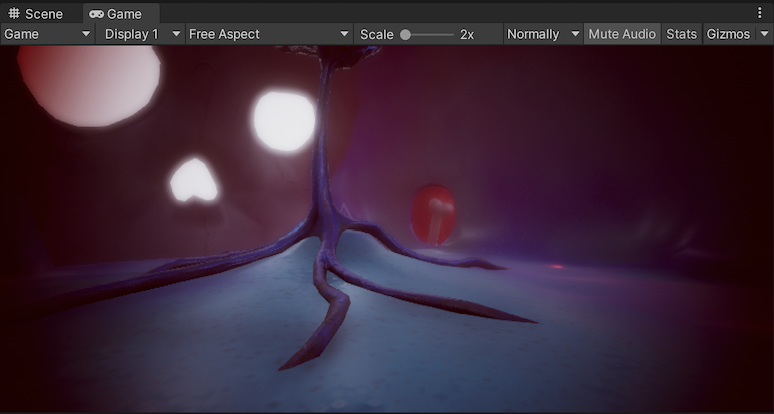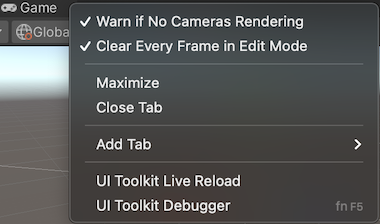游戏视图

从应用程序中的摄像机渲染游戏视图。游戏视图显示最终构建的应用程序的外观。需要使用一个或多个摄像机来控制玩家在使用应用程序时看到的内容。
游戏视图包含在默认 Unity 编辑器布局中。如果未打开游戏视图,请选择窗口 (Window) > 通用 (General) 并选择游戏 (Game) 以打开游戏视图。
在编辑器中,可以在游戏视图和模拟器视图之间切换。模拟器视图显示构建的应用程序在移动设备上的外观。
播放模式

使用播放模式来运行你的项目,并测试它在已构建应用程序中的实际运行效果。
使用工具栏中的 Play 模式控制按钮来控制播放模式:
- 按 Play 按钮可将编辑器切换到播放模式。
- 单击 Pause 按钮暂停播放模式。
- 按 Step 按钮可将播放模式向前移动一帧。
在运行模式下,所做的任何更改都是暂时的,在退出运行模式后将会重置。进入播放模式时,编辑器会在游戏视图之外使界面的某些部分变暗。
使用模拟器视图
使用模拟器视图可预览构建的应用程序在移动设备上的外观。
要在游戏和 模拟器视图之间切换,请在游戏/模拟器 (Game/Simulator) 选项卡中,从游戏/模拟器 (Game/Simulator) 菜单中选择一个选项。
或者,要打开模拟器视图,请选 窗口 (Window) > 通用 (General) 并选择设备模拟器 (Device Simulator)。如果没有打开模拟器视图的实例,则会将其打开为浮动窗口。但是,如果已在编辑器中打开模拟器视图,则尝试从菜单中打开模拟器视图会使其获得焦点
游戏视图控制栏
游戏视图控制栏位于游戏视图的顶部,其中包含用于控制游戏视图的选项。
| 属性 | 描述 | |
|---|---|---|
| Game/Simulator | 选择 游戏或模拟器 视图。使用游戏视图可预览最终构建的应用程序的外观。使用模拟器视图可预览构建的应用程序在移动设备上的外观。 | |
| Display | 选择要在游戏视图中渲染的显示。如果在场景中有多个具有摄像机组件的游戏对象,请选择一个选项在它们之间进行切换。默认情况下,Display 设置为 Display 1。可以在摄像机组件检视面板中的 Target Display 下将显示分配给摄像机。 | |
| Aspect ratio | 测试游戏在具有不同宽高比的显示器上的显示效果。默认情况下,__Aspect ratio__ 设置为 Free Aspect。 | |
| Low Resolution Aspect Ratios | 选择宽高比后,此功能会模拟分辨率更低的显示屏的像素密度,并降低游戏视图的分辨率。游戏视图位于非 Retina 显示屏上时,__Low Resolution Aspect Ratios__ 始终处于启用状态。 | |
| VSync (Game view only) | 允许同步。例如,录制视频时可进行同步。编辑器会尝试以显示器的刷新率渲染游戏视图,但不保证一定能够进行。启用此选项后,在运行模式下最大化游戏视图仍然很有用,可以隐藏其他视图并减少编辑器渲染的视图数量。 | |
| Scale slider | 增大或减小游戏视图的比例。向右滚动可放大并更详细检查游戏视图的区域。设备分辨率高于游戏视图窗口大小的情况下,此滑动条可缩小视图以显示整个屏幕。在应用程序停止或暂停时,也可以使用滚轮和鼠标中键来执行此操作。 | |
| Play Mode behavior | 本节介绍基于以下选择的播放模式行为。 | |
| Play Focused | 当编辑器处于播放模式时,将焦点转移到所选游戏视图。 进入播放模式时,只能有一个游戏视图获得焦点。使用 Maximumed 模式表示关注 Maximumed Game 视图。启用 Focused on a Game 视图会在其他游戏视图上禁用该视图。 |
|
| Play Maximumed | 运行运行模式,游戏视图最大化到编辑器窗口的 100%。即使启用了 Play Maximumed,暂停播放模式时,游戏视图也会恢复到进入播放模式之前的窗口状态。这表示仅当游戏视图在进入运行模式之前已最大化时,游戏视图才会在暂停运行模式时保持最大化。 | |
| Play Unfocused | 进入播放模式时,不要将焦点转移到所选游戏视图。 | |
| Open the Frame Debugger | 打开帧调试器 (Frame Debugger) 窗口。 | |
| Mute audio | 进入运行模式时,禁用任何应用程序内的音频。 | |
| Unity Shortcuts | 禁用编辑器键盘快捷键,使其在运行模式期间在游戏视图窗口未获得焦点时触发。 | |
| Stats | 显示或隐藏数据统计覆盖层,其中包含有关应用音频和图形的渲染统计信息。使用数据统计覆盖层可监控运行模式下应用程序的性能。 | |
| Gizmos | 显示或隐藏 辅助图标菜单。使用 辅助图标 菜单选择要在播放模式下隐藏或显示的辅助图标。 | |
辅助图标菜单
辅助图标菜单包含的一些选项用于控制 Unity 如何在场景视图和游戏视图中显示游戏对象的辅助图标以及其他项。此菜单在场景视图和游戏视图中均可用。有关更多信息,请参阅辅助图标菜单。
高级选项
右键单击游戏 (Game) 选项卡可以显示游戏视图的高级选项。

高级游戏视图选项包含:
- __Warn if No Cameras Rendering__:如果没有摄像机渲染到屏幕,编辑器会显示警告。例如,使用此选项可诊断意外删除或禁用摄像机等问题。除有意不使用摄像机来渲染应用程序的情况外,应将此选项保持启用状态。默认情况下会启用此选项。
- __Clear Every Frame in Edit Mode__:在应用程序未运行时,编辑器会每帧清除游戏视图。这可以防止在配置应用程序时出现拖尾效果。除非在未处于播放模式时依赖于前一帧的内容,否则应将此选项保持启用状态。默认情况下会启用此选项。